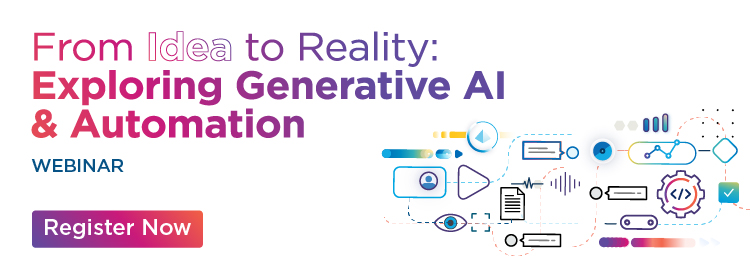Blog
Generative AI Use Cases: Expanding the Power of Automation
Contact Us
Recently, there has been an explosion of artificial intelligence (AI) technologies. Generative AI is being used to generate novel content, including text, images, videos, code and music. Meanwhile, predictive AI is being used to predict future events. And machine learning (ML) is wrapped up in all of it.
A few years ago, asking a computer to create a unique picture or song sounded far-fetched. But now, that magical thinking is a reality – and a lot of organizations are wondering how they can use these moonshot technologies to improve their businesses.
It’s actually not a ‘versus’ at all. Machine learning (ML) is the foundation for both predictive AI and gen AI. But while gen AI uses ML models to create content, predictive AI uses ML to identify early warning signs and determine future outcomes.
While they both use ML and AI, their algorithms function differently. You’ll see some crossover in how these technologies can be applied in real-world use cases.
Think of gen AI as the ‘creative’ one. Gen AI uses deep learning to generate new content based on the data it’s trained on.
Think of predictive AI as the ‘business’ one. Predictive AI, also called predictive analytics, uses historical and current data to identify patterns and make inferences based on that information. It relies on statistical algorithms and ML.
Let’s compare gen AI and predictive AI:
Generative AI | Predictive AI |
Focuses on creating new content. | Focuses on forecasting future events. |
Used to generate realistic images and other novel content. | Used for identifying patterns and making predictions. |
Uses neural networks and machine learning. | Uses statistical models and machine learning algorithms. |

Generative AI is about creating something new.
Gen AI technologies are trained on a set of data and can only generate based on the information it’s fed. Risks of gen AI come with poor data quality or data containing unlicensed content, which can lead to copyright infringement, privacy breaches, bias and non-compliance.
To mitigate these risks, organizations using gen AI should establish AI governance standards, especially those in heavily regulated industries such as financial services and healthcare. Ensuring AI compliance can save organizations from legal fines, data breaches and participation in non-ethical activities.
Generative AI tools are designed to augment the work of writers, designers, artists, coders and musicians – not replace it. It’s especially useful for speeding up the creative process and brainstorming new or different ideas. Any organization wanting to use these tools should first look at how to prepare for generative AI.
Here are the benefits we’ll see in future gen AI uses:
Moving beyond content creation, gen AI has a lot of business use cases. By applying gen AI to your intelligent automation program, you can further optimize and personalize automated processes. Generative AI applications include:
Explore other generative AI use cases to expand the power of automation.
Predictive AI is about forecasting.
Since predictive AI trains on large amounts of data to forecast, a lack of data or inaccurate data can severely hinder its efficacy. And even with all this data, predictive AI isn’t a fool-proof fortune teller. It can make predictions based on patterns and trends, but no future events can be predicted with absolute certainty. Any organization utilizing this technology needs to recognize that, as with all things, there are limitations to technology.
Predictive AI models are designed to speed up decision-making by helping businesses make accurate, informed decisions. It analyzes patterns and makes predictions by identifying data anomalies and extrapolating future events. This can reduce the time it takes for businesses to research or study information so they can focus more time on strategic decision-making.
Predictive AI applications include:
The goal of intelligent automation is to save time and money and optimize processes to reduce waste. With advances in AI technologies, these capabilities will continue to expand as you can automate more complex processes as well as automate more processes end-to-end.
More organizations are thinking bigger about automation. Read our e-book to find out how you can supercharge intelligent automation with generative AI.
Need a refresher? Here’s our table of technologies:
Mimics human intelligence to solve problems. | |
Predictive AI | Also known as predictive analytics, predictive AI uses machine learning algorithms based on historical data to identify patterns, make predictions and forecast trends. |
Uses a sophisticated algorithm to create new content such as texts, images, video and audio based on natural language prompts. | |
Machine learning (ML) | Is a branch of AI that uses data and algorithms to mimic human learning and improve its accuracy over time. |
Natural language processing (NLP) | Is an ML technology that synthesizes natural human language. |
Another name for intelligent automation, cognitive automation mimics human behavior and intelligence to facilitate decision-making and perform complex tasks. | |
Business process management (BPM) | Is a tool for businesses to automate, manage and optimize their processes. |
Robotic process automation (RPA) | Mimics human’s ability to do tasks. |
IA combines BPM, AI and RPA to automate processes. |

If your network blocks YouTube, you may not be able to view the video on this page. In this case, please use another device. Pressing play on the video will set third-party YouTube cookies. Please read our Cookies Policy for more information.